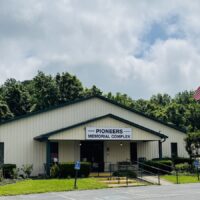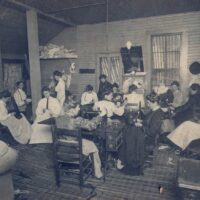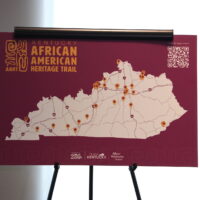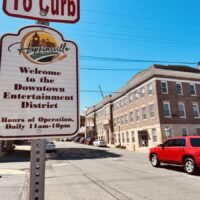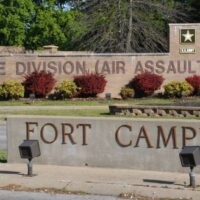They huddle on the bench, the best seats they can find without a dugout. They’re chatting as they wait to take the field again. A dipper sits on top of a wooden water barrel. Men and women pack the bleachers, dressed to impress in skirts, ties and hats. The batboy practices his grip on the baseball — taking pointers from the men who have made it to the minor leagues. I can smell the sweat and the dirt as the photographer releases his shutter.
CLICK!
A competitive moment is captured.
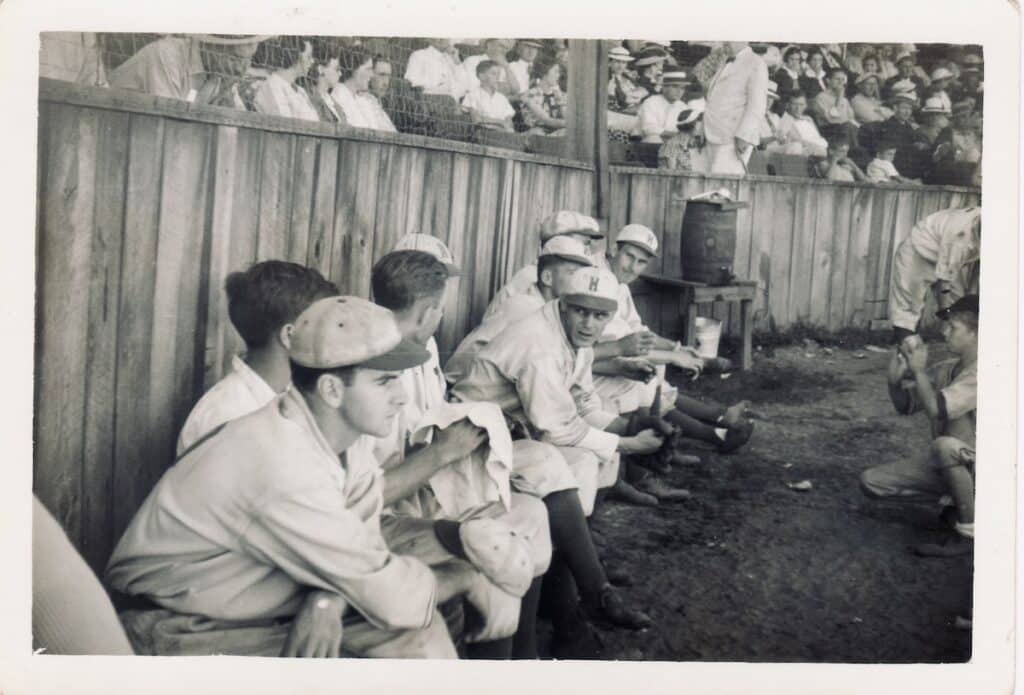
This photograph transports us back to 1937 and onto the field of Mercer Park. The Hoptown Hoppers made their debut in Hopkinsville with the first incarnation of the Kitty League in 1903. And like the feline for which it earned its nickname, the league had multiple lives. This picture, from the vast collection of Christian County Historian William T. Turner, is from its fifth life. Over its storied, on-again-off-again existence, the Kitty League supplied five decades of summer excitement for Hopkinsville and the surrounding region. All told, 29 communities hosted teams, and the league produced more than 60 major league players.
But I’m getting ahead of myself. We have to go back even further to weave the tale of baseball in this community. So grab your peanuts and Cracker Jacks and settle in.
Inning 1: Earliest days
Although its origins are believed to date to the late 18th century, baseball really hit the scene in a big way after the Civil War. The first mention of a baseball team that I could find in Hopkinsville was in 1882. On July 25 of that year, the South Kentuckian reported that the Hopkinsville baseball club was “defeated by the Asylum nine last week.” The writer neglected to inform readers if the team from Western State Hospital was made up of workers or patients.
In 1885, the newspaper told of a game played between the married men’s and the single men’s teams. The married men lost 44 to 29 — in what has to be one of the highest scoring games ever played in the county.
Amateur teams dominated the scene for the rest of the 19th century and even into the first couple of decades of the 20th century. But they’re out for now. You’re not going to believe who’s up to bat in the second inning.
Inning 2: Bloomers make an appearance
Next up: the Bloomer Girls! Say what?! Yes, long before women took the field while men were serving overseas in World War II and even longer before Geena Davis, Madonna, and Tom Hanks made “A League of Their Own” famous, there were the Bloomer Girls. With baseball experiencing unprecedented popularity, women carved out a small spot for themselves at the turn of the 20th century. Exhibition-style teams from larger northern cities like Chicago and Cleveland traveled widely and played against local men’s teams. And they came to Hoptown!
In 1899, the Chicago bloomer girls played — and lost— to the local team before a large crowd. In 1915, a team returned to play against a local team composed of members of Company D of the Kentucky State Guard. The newspaper said, “The Bloomer Girls’ team is the only girls’ team in baseball and is said to be able to put up a hard fight against any amateur club.” The men of Co. D managed to defeat the women, 9 to 6.
While no mention was made of Hopkinsville or Christian County women forming a team, there was a women’s team formed in Russellville in 1880.
After two innings, we move on from amateur and exhibition teams to the minor leagues.
Inning 3: The league blooms, then withers
Dr. Frank Bassett steps up to the plate and hits it out of the park!
The K.I.T. League brought professional baseball to small towns in Kentucky, Indiana, Illinois and Tennessee — and Bassett was the mastermind behind it all. A native of Stephensport, Kentucky, he moved to Hopkinsville around 1890 to work in his brother’s hardware store. After medical school, he returned to Hopkinsville and served as county court clerk from 1918 to 1950. William Turner describes Dr. Bassett as a combination of Robin Hood and Santa Claus to this community.
In its first season, the nicknamed Kitty League had teams in Hopkinsville, Henderson, Madisonville, Owensboro, and Paducah, as well as Clarksville, Tennessee, and Cairo, Illinois. As a Class D league, the players’ contracts were protected, but any higher class (Classes A through C) could draft a player for a set price. Class D leagues were for cities with an aggregate population up to 200,000 and, like all minor league teams, served as farm clubs for the majors. Because of their affiliation with teams from across the country, these minor league teams brought in men from near and far to play. Locals opened their homes and their hearts to these young men, and communities took pride in rooting for their home team.
The biggest name that first year was Charles “Gabby” Street. After his season with the Hoppers in the Kitty League, he played in the major leagues from 1904-1912. In 1908, he caught a baseball dropped from the 555-foot-tall Washington Monument. It took him 13 tries, but he did it.
In spite of Bassett’s strong start in this inning, the league struck out at the end of 1906, returned to the plate in 1910 to strike out in 1914 and again in 1916. Teams from 1922 to 1924 tried to make a run at it again — only to leave the field for the next eleven years.
Inning 4: Defeating Depression and WWII
At bat once again is Dr. Frank Bassett. After an 11-year hiatus, the Kitty League — under the leadership of Bassett — returned in 1935 with six teams: Hopkinsville and Paducah in Kentucky; Jackson, Lexington, and Union City in Tennessee; and Portageville, Missouri. As the league evolved, so did the franchise locations. Fulton and Mayfield teams were added during this revival, and the Portageville and Lexington teams moved to Owensboro and Bowling Green, respectively.
Initially, this revival saw bigger crowds and better talent, but it also saw major changes in leadership. After founding, leading, and funding the league from its beginnings and through three reincarnations, Dr. Bassett was ousted as president after the 1937 season. In 1941, another Hopkinsvillian, Shelby Peace, took the reins until the league folded on June 16, 1942. Poor attendance was the main culprit, but I figure WWII didn’t help.
The 1937 team pictured here takes the field in the top of the sixth inning. But first, the post-war Kitty League and Hoppers need their moment.
Inning 5: Kitty booms
A changed world welcomed the Kitty Leaguers back in a huge fashion. From 1946 to 1955, the Kitty League, with Shelby Peace at its helm, experienced its greatest highs before crashing to its final demise. With teams from Kentucky, Illinois, and Tennessee — the full K.I.T. of its name — the league boasted attendance numbers of 350,000 or more in the 1947 and 1948 seasons. Here, the Hoptown Hoppers played at the brand new Kentucky Baseball Park. Replacing Mercer Park, it stood at the north end of Kentucky Avenue on the west side of town and was partially constructed out of lumber from the previous home of the Hoppers. Billy Goff, owner of the Hoppers (and of a grocery store), built the park that served as the home of our team until their end.
For a while, attendance and support were off the charts. But the huge numbers in the stands decreased steadily. Hopkinsville, which had played in all but two seasons since the league’s inception, did not return in 1955. And the death knell tolled. The league played its final games in September 1955. There was hope for yet another revival, but Peace’s death in 1958 signified the ultimate end of the league. At least, the league as we knew it then.
With Bassett and Peace out of the game, we turn back to our photograph once again. Welcome to the field: the 1937 Hoppers led by manager Richard P. “Red” Smith.
Inning 6: The 1937 Hoppers
The 1937 Hoppers opened their season on May 11 at Mercer Park — located roughly at the site of today’s Christian County Justice Center parking lot — with 1,217 paying fans, the Kentucky New Era reported. The Hoppers beat the Owensboro Oilers, 4 to 2, in the first opening-night victory for the Hoppers in nearly two decades. The line-up included Louis Ahlf, pitcher; Joe Just, catcher; Melvin Hoppe, first base; Jimmy Leopold, second base; Stan Galle, shortstop; Mickey McGuire, third base; Emmett Mortell, right field; Carl Alto, center field; and someone referred to as “Smokie” in left field.
Of the 29 men on the roster, 18 played for the Hoppers in just the 1937 season. One, Emmett Sommers, was also on the 1936 team, while eight more wore the red “H” again in 1938. Only two, Carl Alto and Mickey McGuire, stayed with the team for three years. The men of the 1938 team won the team’s first championship.
These young men ranged in age from 18 to 26 with the exception of 33-year-old manager Red Smith. And these weren’t local boys. Most came from Wisconsin, Ohio, Pennsylvania, and beyond, and many were children of immigrants. The team’s affiliation with the Cleveland Indians — and the manager’s connection to the Upper Midwest — likely drew men from that area.
For a complete team roster with statistics for all you sports fanatics, check out baseball-reference.com and specifically 1937 Hoptown Hoppers. I’m not a sports person (I’m trying really hard here), and this site blew my mind. If you like baseball and you like numbers, this site is for you. I foresee my dad spending hours here.
In spite of my best efforts, I have only been able to identify one man in the picture. The player on the far end of the bench is Jack Hallett, the right-handed pitcher from Ohio. Look for him to make his appearance after the seventh inning stretch.
Inning 7: Who’s Who in ‘37
The 1937 Hoptown Hoppers produced a number of remarkable baseball players. The seventh inning features the four men on the team who played in the major leagues: Richard P. “Red” Smith, Stan Galle, Jack Hallett, and Joe Just.
Red Smith led the 1937 and ‘38 teams as the manager and sometimes catcher, but that’s just a small blip in his story. Born in 1904 in Brokaw, Wisconsin, this son of a German immigrant would make his way to the field in both professional baseball and football. His obituary, printed in the Green Bay Press-Gazette on March 9, 1978, recounts his career as a former Green Bay Packer player and the team’s first official assistant coach to stints coaching baseball at Georgetown University and for the Chicago Cubs. Notre Dame played both sports — one in the fall, one in the spring — for consecutive seasons in the late 1920s.
The catcher played for the New York Giants — the baseball, not football team — for one game in 1927 and earned $4,200. Smith also played in the International League and the Eastern League before turning to managing and coaching both sports. He was with the Hoppers for the 1937 and ‘38 summer seasons while coaching for the Green Bay Packers in the fall. He made his way back to the big leagues in 1945 as a coach for the Chicago Cubs until 1949. In 1951, he became general manager of the American Association’s Milwaukee Brewers and shifted the franchise to Toledo in 1953. He stuck with his history as a brewer — but in a different sense — when he became the general manager of Buckeye Brewing Co. He worked in the brewing industry until his retirement. Smith died in 1978.
Stan Galle (short for Galaszewski) made his debut in the minor and major leagues at age of 18 on the field of our own Mercer Park. A native of Milwaukee, the infielder for the Hoppers played eight seasons in the minor leagues, including two in Hoptown and one in the majors, for about one month, with the Washington Senators. He served in the Coast Guard in WWII, returned to the minor leagues for the 1946 season, and was a manager in 1951. He died in 2000 and is buried in Mobile, Alabama.
7th Inning stretch
Jack Hallett played 14 total baseball seasons — from 1934 to 1943 and from 1946 to 1949 — in the minor and major leagues. Although he was with the Hoppers for only one season, he holds the record for the 1937 Hopper who played the most seasons in the major leagues with six total. The 6-foot-4 pitcher from Toledo, Ohio, played for the Chicago White Sox in 1940 and 1941, for the Pittsburgh Pirates in 1942, 1943, and 1946, and for the New York Giants for a couple of games in 1948.
Hallett’s hiatus in the mid-1940s was to serve in the U.S. Navy where he became director of athletics for navy personnel in Maui, Hawaii, and played in a once-in-a-lifetime series. In late September 1944, more than 40 major league players found themselves stationed together on the islands. What do you do with half a million soldiers jammed together on an island? You play ball! The 7th Air Force — which also represented the Army — challenged an all-star team from the Navy that included Hallett for a seven-game series. The Navy team dominated, winning the first six games. In spite of the solid series victory for the Navy, the teams played the full seven-game series. (I discovered this story in the Oct. 19, 1982, edition of the Honolulu Advertiser) After his career wrapped up in 1949, Hallett lived in his hometown and worked as a salesman until his death in 1982.
Our last major leaguer of the 1937 Hoppers team is Joe Just. Just (short for Juszczak) joined the Hoppers in his second year in the minor leagues and only stayed with the team for one season. The son of Polish immigrants played 13 seasons in the minors, from 1936 to 1950. During that period, he had two partial seasons with the Cincinnati Reds. He played 25 games and started as the catcher in 11. He played in the International League in 1946, ‘47, and ‘49. He managed teams in the South Atlantic, Big State and Northern leagues in the late 1950s. Just retired to Baileys Harbor in Wisconsin and died in 2006.
Those were the guys who made it to the major leagues, but I’ve got one more story of the 1937 Hoppers to tell in the eighth inning.
Inning 8: Art Grangaard’s stunt
Now we turn the spotlight to another member of the 1937 Hoppers team, Art “Whitey” Grangaard. The all-star outfielder played just one season for the Hoppers, but he made a big name for himself when he successfully won a ballpark bet. On July 27, 1937, the North Dakota native caught a baseball dropped from the top of the Jefferson Davis Monument. This stunt was reminiscent of former Hopper Gabby Street’s history-making catch from the Washington Monument nearly 30 years prior. Grangaard caught both the eighth and ninth balls dropped from the 351-foot obelisk at Fairview.
Grangaard served in the Navy during WWII, coached baseball at St. Olaf College, and sold life insurance. He was inducted into the West Central Minnesota Baseball Hall of Fame as part of its inaugural class in 2014.
Our game is winding down.
Inning 9: Hoppers return
In 2012, the Hoppers returned to Hoptown. Now part of the Ohio Valley League, the Hoppers are collegiate players who spend the summer training, playing and entertaining fans in the wooden bat league. The Hoptown Hoppers have won three league championships, and most importantly, they’ve won the hearts of this community. Just like their predecessors from 1903 to 1954, these young men come to our community as strangers and leave as family. They give us all something — someone — to cheer for each summer.
If you haven’t made it to a game this summer, you still have a few chances! The playoffs start later this week.
The ninth inning wraps up with the most recent incarnation of the Hoptown Hoppers, but the game isn’t settled. Not yet.
Extra Innings: A Surprise
You might think that the game — and our story — are both over. Oh no, my friends. There’s a surprise that I stumbled upon in my research that I decided to save for our extra inning. That’s when the game really gets good, right?
It is of no surprise that the Kitty League only included white players. The major leagues didn’t integrate until 1947 when Jackie Robinson joined the Brooklyn Dodgers, but African Americans played baseball — both on an amateur and professional level — long before then. And they played in Hopkinsville and Christian County, too.
The first reference I found to African Americans playing baseball in Hopkinsville was in the newspaper in 1883, just one year after the first reference of anyone playing baseball here. A local team played a team from Clarksville in a rousing game that ended with Clarksville winning 43 to 37. In 1887, the Hopkinsville Hard Hitters played the Henderson Dukes, and in 1888, the Hopkinsville team “walloped” the Trenton team and planned to play a team from Nashville at Sharp’s Field (likely located in the vicinity of Joe Mumford Park today).
Hopkinsville native Harry Buckner made a big name for himself in baseball. After playing for teams in Hopkinsville in the 1890s (and after a short prison stint for assaulting a man with a baseball bat), Buckner was recruited to play for the London Creole Giants in Muncie, Indiana. He played for the Chicago Unions, Philadelphia Giants, Cuban X-Giants and the Brooklyn Royal Giants. After retiring from the game in 1917, he worked as a trainer for the Milwaukee Brewers for 18 years. His biography is available online at the Society for American Baseball Research.
Fast forward to 1940. While the Kitty League’s Hoptown Hoppers were playing, an African American team known as the Black Hoppers were, too! Managed by George McCray, the Black Hoppers played teams from as close as Elkton, Guthrie and Clarksville, and from as far away as Middlesboro in Eastern Kentucky. The team played its first home game under the lights at Mercer Park on July 12, 1940. Local merchants supported the team financially and helped secure their new uniforms.
On Aug. 1, the Black Hoppers held a parade before they played a team from Gallatin, Tennessee. The parade started at Brown’s grocery on Second Street and circled through the neighborhood, going as far “uptown” as Sixth Street. A 25-piece band from Gallatin joined in the festivities. Special sections, sometimes up to half of the grandstand, were reserved for white fans.
Few player names are given in articles about the Black Hoppers. George Baker and Charlie Baker are both listed as pitchers, and Bill Wills is listed as a catcher. James Johnson and Gus Howell, both from Cadiz, joined the team mid-season, as did Dave Cole, who had played with a team from Crofton known as the Crofton Browns. The network of these amateur African American teams stretched far and wide and included many young men from Hopkinsville and Christian County.
One reference I found indicated that the Black Hoppers played until at least 1946. The online newspaper archives are spotty at best for this time period, and they left me without any information past the 1940 season. I would love to learn more about the Black Hoppers — who they were, where they came from, and what happened to them. If you have stories or pictures to share, please let us know!
And with that, our game and our story are both over. In the end, I totally forgot to keep score of this saga of a game. To me, the score isn’t important. What is important is Hopkinsville’s connection to the most all-American of all things American — baseball. The legacy of the game extends deeply into our history and continues to bring competition and a sense of community to us each summer.
So, who’s the winner? We are. We have been for a long time.
Thanks to the lifelong dedication of William T. Turner and to the thorough review of the league by Joshua R. Maxwell and Kevin D. McCann, much of the league’s history has been captured and preserved in the book “Kitty League.” It is available in The Vault by Planters Bank, the gift shop in the Pennyroyal Area Museum. This article leaned heavily on their research.
Alissa Keller is the executive director of the Museums of Historic Hopkinsville-Christian County. She’s a graduate of Centre College with degrees in history and English and of Clemson University/College of Charleston with a master’s degree in historic preservation. She serves on the Kentucky Historical Society and the Kentucky Museum and Heritage Alliance boards.
